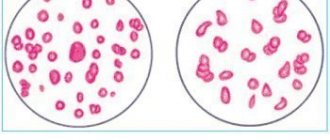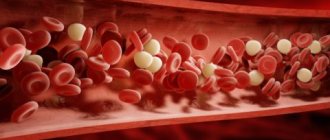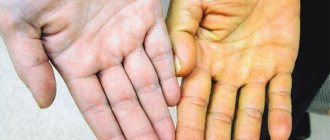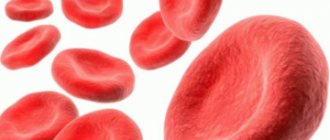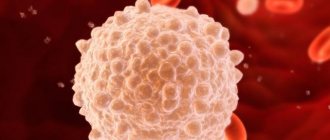What is PDW and its importance for the body
PDW in blood testing is a designation for the distribution of blood cells in the bloodstream. Such a blood test is necessary to determine the presence of certain pathogenic processes in humans. Platelets are heterogeneous in nature; both small and large cells are found. There is a somewhat similar meaning - RDW, but it refers to the volume of red blood cells in the bloodstream.
Platelets are an important part of human blood. When a blood vessel is damaged, they accumulate at the site of injury and thereby stop the bleeding.
If there are few of them, the person is in danger of losing a large amount of blood. If, on the contrary, there are more platelets, this can cause the formation of blood clots, which, if they come off, can block the vessel. This is dangerous, since completely blocking the blood flow causes tissue death and, in some cases, death.
Therefore, the PDW indicator is very important - it determines whether the level of platelets in the blood is high or low. If the results are significantly abnormal, together with other tests that are not good enough, this may indicate the presence of serious diseases.
Pathological changes in indicators
Changes in indices indicate the presence of diseases of various natures in the body. To take correct measures to eliminate the cause, it is necessary to carry out the analysis several times during the treatment period. This will also allow an assessment of the quality of the prescribed therapy and the degree of disease progression.
Average platelet volume
| MPV volume increased | Volume reduced |
| Thrombocytopenia (forced destruction of platelets) | Megakaryocytic hypoplasia |
| Diabetes | After a course of chemotherapy |
| Enlarged spleen | X-linked thrombocytopenia in the presence of microcytosis |
| Hypersplenism | Septic thrombocytopenia |
| Vascular atherosclerosis | Aplastic anemia |
| Thyroid disorders | Megaloblastic anemia |
| Increased myeloproliferative processes | Wiskott-Aldrich syndrome |
| Bernard-Soulier dystrophy | Cirrhosis of the liver |
| May-Hegglin anomaly | Myelodysplastic syndrome |
| Uncontrolled drinking of alcoholic beverages | During radiation treatment |
| Tobacco abuse | Cytostatic therapy |
| After splenectomy | Splenomegaly |
| Development of infectious inflammation | Leukemia |
| Beginning of tumor formation | Malignant bone marrow tumor |
| Thalassemia | Infectious diseases (rubella, measles, influenza) |
| Posthemorrhagic anemia | |
| Systemic lupus erythematosus |
The average platelet cell volume in the test may be lower than normal when taking certain medications.
Width of platelet distribution by volume
| Index increased | Index below normal |
| progressive inflammatory processes | Aplastic anemia |
| Malignant neoplasms | Leukemia |
| Anemia | Gaucher disease |
| Period after surgery | Niemann-Pick disease |
| Muscle strains | Myelodysplastic syndrome |
| Loss of large volume of blood | Metastasis of a malignant tumor to the bone marrow |
| Thrombocytosis of a tumor nature | Radiation sickness |
| Immune thrombocytopenia | Carrying out therapy with cytostatics |
| Thrombocytopathy | Immune thrombocytopenia |
| Diseases of myeloneoplastic nature | DIC syndrome |
| Splenomegaly | |
| Chronic hepatitis |
Thrombocrit
| Index increased | Index reduction |
| Essential thrombocythemia | Aplastic anemia |
| Chronic myeloid leukemia | Splenomegaly |
| Inflammatory processes | Myelodysplastic syndrome |
| Subleukemic myelosis | Hemoblastoses |
| After splenectomy | Anemia associated with vitamin B12 deficiency |
| Thrombocytosis in iron deficiency | Liver diseases |
| The period of myelosuppression during radiation or cytostatic treatment |
How and under what conditions is it formed?
PDW stands for platelet distribution across blood volume. These are the smallest blood cells, their size is no more than 3-5 microns. The cells themselves are flat and oval in shape, they are transparent and nuclear-free.
Platelets have their own purpose:
- produce reactions in which a blood clot is formed that can stop bleeding in areas of tissue damage (internal and external);
- promote the growth and restoration of blood vessels, provide nutrition with bioactive substances;
- eliminate the inflammatory process along with the delivered immune complexes;
- purification of blood (filtration) from antigens.
Platelets are formed in the bone marrow. Most of them are located in the blood vessels, the smaller part is in the spleen. In this organ (as well as in the liver) the disposal of dead, colorless bodies occurs. The life of platelets is 8-11 days. In this case, the synthesis of new cells occurs without interruption. Both young and old can be present in the blood at the same time.
In total, red cells have several stages of life:
- youth;
- maturity;
- old age;
- irritability;
- degeneracy.
Its size also depends on what stage the platelet is at – the older it is, the smaller it is. Cell volume heterogeneity is also determined by PDW (heterogeneity). If the remaining cells circulate in the blood in their normal volume, minor deviations from the norm do not mean pathology. PDW analysis is performed immediately with MPV, the average red cell volume.
Platelets and the concept of pdw in the bloodstream
The abbreviation RDW can be deciphered as “platelet disintegration width by volume.” On the laboratory form it represents the platelet distribution index. These cells are the most microscopic in size compared to other elements of the blood channel, their size varies from 2–5 micrometers. Platelets are often called platelets because they have a flat, oval shape with projections. These shaped particles are transparent and do not have a nucleus.
Purpose of platelets:
- Release of factors for blood clotting with the aim of forming blood clots in the area of violation of the integrity of the internal or external soft tissues of the body.
- Production of growth factors for the restoration of blood vascular walls and their nutrition, by providing biologically active components.
- Supply of immune complexes to the sites of the inflammatory process to eliminate it.
- Filtration of blood from antigens destroyed by combining them with antibodies.
The synthesis of flat, nuclear-free bodies occurs in the main hematopoietic organ - the bone marrow. The predominant number of platelets, about 80%, is present in the bloodstream, while a small part of about 20% is constantly located in the spleen. Here and partly in the liver, the disposal of obsolete colorless, flat cells is carried out. The existence of platelets lasts only 8–12 days.
The formation and elimination of platelets and other formed microparticles of blood is carried out continuously. At the same time, the circulatory system contains cells that are at different stages of development.
There are five stages of platelet existence:
- Youth phase.
- Maturity stage.
- The period of old age.
- Stage of irritation.
- Degenerative moment.
The volume of the cell depends on the stage of formation - new cells are larger in size. As they mature and get closer to aging, they decrease in size. The pdw readings just demonstrate the heterogeneity and width of platelet distribution throughout the volume of the blood substance. In other words, this indicator determines the heterogeneity of platelets.
Data in laboratory forms are displayed in percentage terms and have an indirect meaning.
Consequently, if the coefficients of the remaining formed cells have a stable value, then non-critical changes associated with platelets do not indicate pathological processes in the body. Pdw blood test is performed simultaneously with determining the MPV indicator, which means.
The predominant number of platelets in the blood should be in a mature form. It is at this stage that flat blood cells are able to cope with their main purpose - to influence blood clotting. The permissible fluctuation in the number of mature platelets, both upward and downward, is 10%. Severe excess of the norm threatens the formation of blood clots, which gradually clog the vessels. A significantly reduced level of platelets is fraught with blood loss.
In a healthy body, the normal width of platelet distribution in children under 18 years of age is from 10 to 15%. In adults, the normal pdw index ranges from 15 to 17%. In a situation where the norm has significant deviations from standard values, this may be a sign of a disruption in the functioning of certain organs and systems in the human body. This may also signal the possible development of pathology.
PDW norm table
PDW - in a blood test - is a value that has both its deviation and its norm.
| Patient | PDW standard | Peculiarities |
| Men | 15-17% | |
| Women | 15-17% | During menstruation, blood is not tested. PDW decreases during this period (it varies for each woman). During pregnancy, the values also change - from the norm to 10-20%. |
| Children | 10-14% | During growth and restructuring of the body, values may change, but only slightly. |
The predominance of old and new platelets should not be higher than 10%, otherwise the risk of blood clot formation increases. While a decrease in level can cause large blood losses.
Increased PDW level: what pathologies does this indicate?
Platelet indices increase in cases such as
:
- presence of anemia (especially during pregnancy);
- blood was drawn incorrectly;
- presence of cancer;
- severe blood loss during surgery or during menstruation in women;
- the presence of an inflammatory process, in which the number of platelets sharply increases, as evidenced by an increase in the width of the distribution.
An increase in PDW level does not always mean the presence of any pathology or the presence of cancer.
Often, when a blood test is suspected of cancer, they are forced to retake it several times, taking into account all the nuances of the procedure. Many patients are unaware of how to prepare properly, which results in inaccurate data. Only those cases where abnormalities in the blood test are noted not only in the PDW indicator, but also in other indicators deserve special attention.
Symptoms of high and low PDW
Symptoms of an increase or decrease in PDW in the blood depend on the disease as a result of which the indicator deviated from the norm. This can occur for various reasons; there are quite a few diseases that can cause PDW to decrease or increase.
For example, an increase in the indicator may indicate that a person has anemia. In this case, this will be expressed by pale skin, low blood pressure, weakness, and an enlarged spleen.
If PDW in a blood test is low, then the person often suffers from low blood pressure
A decrease can also mean various reasons, including a lack of vitamin B12 and folic acid. A deficiency of these elements is expressed in problems of the nervous system, severe hair loss, and a tendency to depression.
Reasons for promotion and demotion
PDW in a blood test is, figuratively speaking, a means of determining the presence of dangerous diseases. Of course, you cannot rely only on the values of this indicator, however, if the figure deviates greatly from the norm, you should think about other analyzes and a complete check in general.
The reasons for increasing PDW are the following:
- oncological diseases (they quite significantly change the composition of the blood as a whole);
- other inflammations;
- anemia;
- bleeding that occurred after surgery.
An increase in performance does not always mean that there are serious problems. Sometimes the reason may be a simple failure to follow the recommendations before taking the tests. Also, the value may deviate from normal due to taking medications that somehow affect the composition of the blood.
Reduced PDW means few cells in the bloodstream.
Discrepancies from the norm may be caused by the following reasons:
- lack of vitamin B12 and vitamin B9;
- dysfunction of the liver and hematopoietic organs;
- oncology;
- various viruses and infectious diseases;
- taking medications such as cytostatics and others.
Women are not recommended to take tests during menstruation, since all readings will, in principle, differ from the norm, and the platelet volume will be reduced.
However, if the cause of low PDW is not determined, deviations from normal values should not be neglected. Reduced volume can have a detrimental effect on organs, affecting their integrity.
Changes in PDW can occur as a result of poor nutrition, bad habits, or physiological characteristics of a particular organism.
What to do?
In the case where such an analysis was taken in the laboratory independently without a doctor’s referral, and the transcript showed the presence of deviations, it is necessary to consult with a specialist.
In most cases, the doctor will suggest taking the same test in several laboratories, after which, if the results still confirm an increase in the width of the platelet distribution, a comprehensive examination will be prescribed. Usually, the presence of serious health problems is indicated not only by an increase in the level of this indicator, but also by other related indicators. Therefore, you should not panic until the doctor makes an accurate diagnosis.
If the presence of deviations from the norm in blood test parameters is supported by accompanying symptoms, it is much easier to make a diagnosis and confirm it with the help of hardware testing. In the absence of symptoms, it is extremely difficult to find the cause of the deviations.
The relative reliability of the blood test results depends entirely not only on the patient himself and his preparedness for blood sampling. Sometimes low-quality reagents, which are most often found in rural clinics, do not accurately determine the composition of the blood, giving false results. In order to reduce the risk of receiving low-quality results that are far from reality, it is recommended to undergo examination in specialized laboratories that have special quality certificates and innovative technology.
Indications for the study
A referral to donate blood for analysis is issued by a physician. After the examination, he makes a conclusion whether the person should worry about his health or not. Tests and subsequent examinations will either confirm fears or refute them.
The patient is sent to the laboratory, where blood is drawn and the resulting material is examined. This takes time. Then all indicators, including PDW, are written out. With the laboratory tests obtained, the person returns to the therapist, and he examines the results obtained.
The results issued by the laboratory may look like a table in which the data is written down (normal and presence in the patient). It may also specifically indicate whether the person has a disability.
How is PDW determined?
PDW in a blood test is a value that can change not only as a result of the occurrence of pathologies in a person, but also due to insufficient preparation for the analysis. The volume and distribution of platelets is determined by donating blood from a finger prick. To obtain a more detailed analysis, a sample is taken from a vein.
In order for the result to be accurate, the patient must prepare in advance:
- 1 day before the test, do not engage in physical activity (red blood cells may increase as a result);
- food intake - at least 8 hours ago, it is best to donate blood on an empty stomach;
- For 1 day you should not eat fatty, salty or spicy foods;
- liquid is taken only in the form of water;
- If possible, you should not take medications the day before the test.
If taking medications is mandatory, this is discussed with the doctor, and subsequent tests will take into account the presence of medicinal substances in the body.
A good time to take a blood test is the morning (before meals). Before starting the procedure, the patient should sit for a few minutes (10-15) to even out the pulse and calm down.
This is important because some people are in a hurry and arrive at the laboratory in a rather agitated state. After donating blood, it is immediately sent for research. Results may come within 1-3 days, depending on the clinic.
The doctor interprets the results. It determines whether the PDW is normal or not from the table and if there is any abnormality, it is recorded. The platelet volume alone cannot make a diagnosis - it is necessary to consider other blood counts and other tests.
Prevention of pdw level deviations
Everyone can maintain healthy blood counts. Initially, it is necessary to keep in mind that the foundation of normal well-being is a healthy lifestyle.
With daily observance of a set of simple rules, the body will delight its owner for many years with excellent indicators, including blood.
Preventive measures to maintain a normal pdw index:
- Maintain a daily drinking regime. More than 90% of the blood flow consists of plasma fluid, which is renewed and circulated due to the constant supply of clean drinking water to the body.
- Adhere to a balanced diet, the basis of which should be high-quality foods rich in vitamins, minerals and other beneficial substances.
- Take daily walks in the fresh air for at least two hours and avoid physical and emotional stress.
- Do not take medications without the supervision of a specialist.
The conditions are actually very easy to implement. But they carry enormous benefits for all systems of functioning of vital processes in the human body. Just by adhering to the correct daily routine, it is possible to prevent the development of serious deviations in the functioning of the body.
To make a diagnosis, after interpreting the pdw test results, the doctor compares them with the symptoms obtained during a visual examination and interview with the patient. In doubtful circumstances, when the clinical picture of platelet degeneration is not completely clear, additional examination may be necessary. The main thing to remember is that you should not self-medicate and neglect blood tests if any minor ailments occur, especially if a child complains of them. And when your health is normal, it makes sense to conduct periodic blood composition tests.
for men and women are no different. The norm is 150 - 400 thousand/µl.
During the day, these values can fluctuate within 10%. This is fine.
During menstruation, their number decreases by 50%. Also . them falls. If the value is below 140 thousand/µl, then doctors sound the alarm and take measures to help reduce the risk of bleeding during childbirth.
Towards quality
include:
- (MPV)
– - (PCT)
- the ratio of the volume of all platelets in relation to the total blood volume or also called -. - (PDW)
– heterogeneity (heterogeneity) or width of platelet distribution by volume.
The functionality of the cells depends on these values. How quickly a clot will form and how long the bleeding will continue.
Important
: quantity, volume, thrombocrit and volume distribution indicator is called platelet index.
It acquires diagnostic value only if there are serious deviations in other blood parameters.
Decoding the analysis results
Decoding PDW implies such designations as normal, increased level and reduced.
The norm is considered to be the case when old and young cells are in the bloodstream in almost identical numbers.
An increase in the indicator is an increase in the content of young and old platelets in the bloodstream, and indicates the presence of some kind of problem in the body. Sometimes an increase in PDW and the absence of any symptoms indicates the possible presence of genetic diseases. To check this, a full examination is carried out.
When PDW is reduced, this means that the vast majority of the bloodstream is made up of old cells. This means that there is a problem in the bone marrow and new blood cells are not being produced as before.
The test may also show that the person has very large platelets. Abnormally large cells indicate problems with the immune system. Sometimes cell size depends on heredity - some hereditary diseases affect the size of blood cells.
Studying the material can give the following result – “incomplete”. This means that the platelets clumped together during the counting process. To continue the study, the laboratory technician adds an anticoagulant to break down the cells.
When platelets diverge from their norm, and the reason for the deviation is unclear, an additional study is prescribed, where all materials will be examined in more detail for the presence of malignant processes, infections and other pathologies.
For which PDW should you see a doctor?
If the results of a laboratory test show a high or low PDW value, this is a reason to consult a physician. The doctor will examine the available results, and may ask related questions, after which a referral will be issued for other tests.
Do not forget that the reason for the increase may be non-compliance with the rules of preparation for procedures and taking medications. If this is the case for changes in indicators, then the person is sent for a repeat blood draw.
How to get PDW back to normal
PDW in a blood test is a value at which it is impossible to accurately determine the diagnosis. Before you begin to bring platelets back to normal, you need to understand why they deviated from their normal state. Therefore, first you should know your diagnosis accurately. Only then does the doctor prescribe the appropriate treatment - a course of medications, hardware therapy, etc.
Special attention is paid to oncological diseases. If the patient has been diagnosed with this, treatment involves special treatment (chemotherapy, radiation therapy, bone marrow cell transplant).
Before using any medication, a person should consult a hematologist. If a child has problems, the pediatrician will prescribe all the necessary medications for treatment.
Medications
If PDW in the blood is low, the doctor may prescribe the following medications:
- Aspirin;
- Clopidogrel;
- Thrombo ACC.
These medications can thin the blood, both for a short time and for a longer period.
When it is necessary, on the contrary, to reduce the indicator, the following drugs may be prescribed:
- Vikasol;
- Dicynone;
- Sedokor.
If a person has undergone a procedure such as chemotherapy, normal PDW is restored by taking hormonal medications.
You should not resort to medications without consulting your doctor - the effects of medications may be unexpected and cause even more problems.
Traditional methods
Traditional medicine will not replace full-fledged treatment, but it can be an additional way to get your health in order.
Home remedies are good during a person’s recovery period after surgery.
One of the most popular recipes for restoring PDW levels is a ginger-honey mixture, the recipe for which is very simple:
- Ginger root is ground into a paste and mixed with honey in equal parts.
- The resulting mixture is placed in the refrigerator for 3 days.
- Throughout the entire course (10 days), this folk remedy must be kept in the cold. You should also not heat honey - because of this, all its nutritional properties are lost.
- The product is taken as follows: 1 tbsp. eaten on an empty stomach. It is important to monitor the body’s reaction, since both of these products are strong allergens. To begin with, you should take 1 tsp.
Even before taking folk remedies, you should consult a doctor, as the condition may worsen, allergies and other side effects may occur. If the condition worsens, you should immediately stop taking home remedies.
Other methods
There are quite a few other methods of treating ailments. First, you should note the diet that your doctor may prescribe for a speedy recovery. Depending on which PDW (low or high), products are selected.
So, with a high value, you should pay attention to:
- berries: currants, cranberries, rose hips;
- bitter chocolate;
- lemon, ginger, garlic;
- flaxseed oil and seed.
If the indicators are low, the following products may be added to the patient’s diet:
- eggs;
- red lean meat;
- sesame;
- cereals (buckwheat, rice);
- beet.
Vitamins B12 and C must be present in the patient’s diet - they help restore blood composition. Vitamins can be taken in the form of vitamin complexes, adding them to the diet. Typically, a course of vitamins is 30 days.
Clinics also use hardware therapy in the form of blood purification with a separator apparatus. This device traps blood cells, thereby reducing PDW. Doctors additionally give recommendations so that after recovery you can maintain normal blood counts.
They are quite simple:
- Be sure to consume a sufficient amount of clean water (up to 2 liters);
- avoid physical overexertion; walking and exercise therapy will be sufficient for the patient;
- following a diet that saturates the body with all the necessary elements and improves the condition of the blood;
- reduce the consumption of medications, especially if they were taken thoughtlessly.
These recommendations will help a person maintain normal levels and prevent the recurrence of pathologies.
What affects indexes
An unreliable result when determining the average platelet volume, volume distribution width and thrombocrit may be higher or lower than normal if the following actions are taken the day before or immediately before collecting material for research:
- Eating food in the morning before the blood test is taken;
- Heavy physical labor both immediately before collecting material and during the day the day before;
- Mental work that requires a lot of concentration;
- The use of various medications in the morning before handing over the material (especially when administered intramuscularly or intravenously);
- X-ray irradiation;
- Carrying out physical procedures before blood collection.
Not all deviations from normal values are pathological
It is possible to obtain a result that will be lowered or increased, and such a platelet value will not be considered a significant deviation from the norm. More often, such deviations can be within 1-2% of normal values, but more significant changes are possible. Most often they occur in the following situations:
- When collecting blood from young children due to incomplete maturation of the hematopoietic system;
- After surgery;
- During the recovery period after receiving numerous injuries;
- The period before menstruation in women or immediately after its end;
- After intense bleeding.
After each of these phenomena, the body intensively produces new platelets, which affects their average volume and other indicators of blood cells.
Possible complications
Ignoring the results of laboratory research can lead to undesirable consequences. If the reason was non-compliance with the rules before taking the exam or the presence of menstruation or pregnancy, then there is no need to worry.
However, deviations from the PDW norm may hide serious diseases that should not be neglected. Without proper examination and treatment, the disease will progress and ultimately lead to death or disability.
Indiscriminate use of medications without a doctor’s prescription can also cause complications and aggravate the situation. If anything in the tests turns out to be abnormal, you should immediately contact your doctor.
The platelet index PDW (platelet distribution width by volume) is an important indicator in a blood test, and a discrepancy with the normal value may indicate the presence of pathogenic processes in the body. A test such as donating blood gives a clear picture of platelet volume and also makes it clear whether further examination and treatment is necessary.
Article design: Mila Friedan
Increase pdw
When the pdw value of a blood test when deciphered is higher than normal, this is a sign of strong platelet heterogeneity in volume. This state of the circulatory system entails serious consequences. As a result of gradual clogging of blood vessels and capillaries, blood circulation becomes difficult. Which leads to numerous consequences, ranging from a slowdown in metabolism to a list of heart attacks.
Increased platelet volume occurs in the following pathologies:
- Bleeding as a result of surgery or injury results in a high level of platelet concentration in the bloodstream.
- Pdw is increased in blood tests with anemia, which provokes oxygen starvation, due to which flat blood cells may be subject to deformation.
- Oncological pathologies in which systematic damage to blood cells and platelets occurs, including. As a result, their volumes change and lead to disruption of the distribution of platelets in the blood mass.
- Inflammatory processes, during the development of which the number of platelets is increased, and hence the width of their distribution by volume. If, in addition, there is an increased level of leukocytes, then all the signs of inflammation are present.
If pdw is elevated, then this is not necessarily evidence of any serious abnormalities in the body. The reason may be non-compliance with simple measures recommended before taking an analysis to determine the extent of platelet distribution in the blood flow. Blood must be donated in the morning and always on an empty stomach; at least 10–12 hours must pass after the current meal. You should refrain from strong physical and emotional stress on the eve of the examination. It is not advisable to take any medications, even multivitamins.
